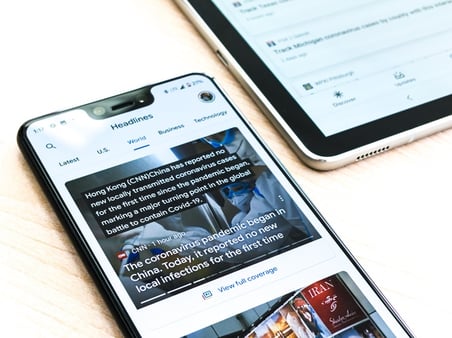The term fake news has been swirling around for a while now but what does it mean and why is it so important to be aware of it on social media? Fake news describes any article or video containing untrue information disguised as a credible news source. It is not necessarily unique to social media, but it has become a huge concern in today’s digital era. What’s the link between the two? This is where fake news most commonly appears as it is the most efficient way to spread information fast, whether true or false. Social media has become an inevitable part of society however this does not mean we should always believe in what is posted there. With the development and increase of users on social media platforms, the control of information posting on social media networks has therefore become out of control. Read on to discover the ins and outs of fake news on social media and how to identify the real facts from the false!
Why does fake news appear mostly on social media platforms?
Today, social media platforms, such as Facebook, Instagram, and Twitter, are the fastest way to share and spread information. Most people digest their daily news intake via these outlets. For the younger generations, social media can be the only way they discover what is going on in the world. So, at the moment to spread fake news, social media is the most efficient way to do it. An important thing to know is that platforms such as Facebook and Twitter do not have third-party technologies to filter any information that is posted online. This means that anyone can share any kind of information. As a result, people are likely to consider information that has not been verified. In essence, there is a lack of control on social media platforms which is why it is so appealing and easy for fake news to be spread. Low cost, efficient, no fact checking or filter, are reasons why social media is the fastest way to connect with any audience.
Examples of fake news on social media
There have been various cases of fake news circling on social media. Some of the most prominent cases took place during the Covid-19 pandemic. Disinformation was being shared, blaming the government, racial groups, and illegal immigrants for the spread of the virus. There were various conspiracy theories blaming China for the spread of Coronavirus without any factual backing and in the UK, there were large amounts of misinformation being spread concerning the vaccinations against the infection. Another more recent example of a fake news blast has been seen during the war between Russia and Ukraine, some even describing it as the world’s first TikTok. A second war unfolded all over the internet and social media thanks to fake news. Manipulated photos, deep fake videos and false statements were all hitting social networks. Some social media platforms even spread an image of Oleksandra Zelenska, the daughter of the President of the Ukraine, allegedly calling her father a Nazi and murderer of the Ukrainian people. This was not true, but many people thought it was. However, by using an image search engine on TinEye, it was discovered that the image of the girl making this statement was in fact a screen shot from a video taken in 2017 in which a girl is complaining that her boyfriend has not given her an iPhone for Christmas. If you compare the two girls closely it is clear they look nothing alike.

How can fake news be identified on social media?
Fake news is nothing new, but many people have a hard time identifying real news from false news. Here are some tips to help distinguish what’s real and what’s not!
Clickbait
Clickbait is an emotional trap. It is a headline that has been intentionally created to make readers want to find out more so they feel forced to click on a hyper link. It is a well-known publishing trick to increase views and any possible advertising revenue.
Reliable Source of Information
Where is this piece of information coming from exactly? Always make sure to check the source and author before you believe what you are reading.
Who is the author?
It is always a good idea to look at the editorial staff or author of a certain piece of information. Are they a credible and newsworthy team? Normally when reading online there is a writer credited so if in doubt, check out what they have written before to see if it’s credible or not.
Read beyond the headline
The goal of any headline is to provoke and stimulate. Fake news stories often have buzzy titles all in capital letters. If the headline is incredibly shocking and doubtworthy then it is usually not trustworthy. It is important to read beyond the headline by reading the full article. Do not be deceived by catchy titles whose sole purpose is for you to click on or tune in to what may not be the truth.
Be critical
When reading anything online, it is useful to think critically when taking in information. Is this article biased in any way? Are there any grammatical mistakes? Reporters may report on events and newsworthy tops without having all the facts or adhering to strict and tight deadlines.
Are you joking?
It can happen that websites online or social media networks will create fake stories to be humorous. Although the news is not intended to harm anyone, when shared out of context it has the potential to be taken the wrong way. Fake news is normally much more serious information but can always be verified by fact checking and digging a little deeper into the story.
Check the Images
Often when fake news appears on social media platforms the videos and images are not of the highest quality. They can appear blurry and not professional.
Always fact check
Checking the facts is of the utmost importance if you are not sure if what you are reading online is fake or not. A good rule of the thumb is to see if you can find the same news or information being told by three additional and, most importantly, credible sources. If this puts you in difficulty, then it is likely you have stumbled on some fake news. Another top tip is to check the timeline and dates. In fake news this is often wrong, and the timeline of events does not always make sense.



 8 min
8 min

 8 min
8 min

 6 min
6 min


 On 9 December, 2022
On 9 December, 2022